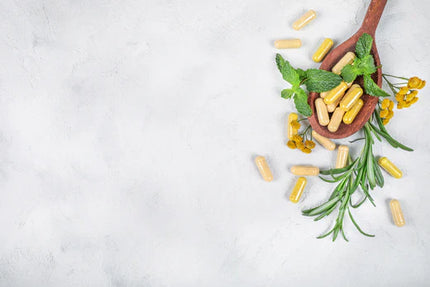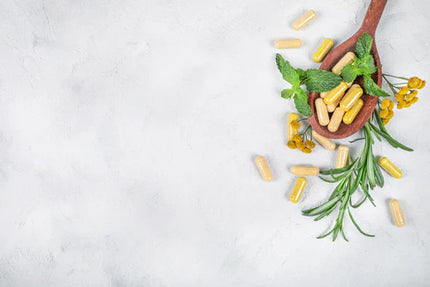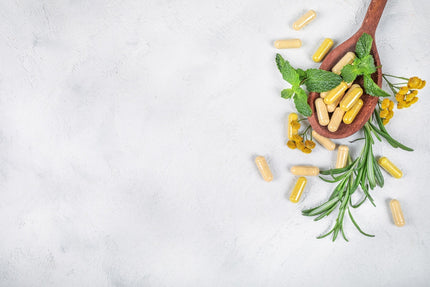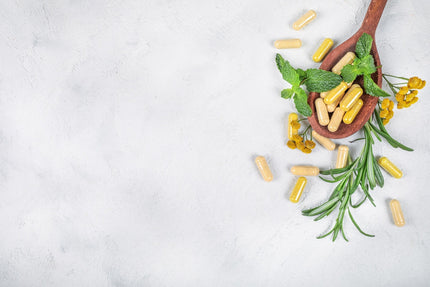Herbs That May Assist
Rehmannia
Rehmannia glutinosa, root dry
American ginseng
Panax quinquefolius, root dry
Wild oats
Avena sativa, herb dry
Lavender
Lavendula angustifolia, herb dry
Actions
- Improves physical and mental performance under stress
- Anxiolytic and nervine
Clinical Applications
- Fatigue
- Nervous exhaustion/Mental Fatigue
- Anxiety
Rehmannia Complex for Nervous Exhaustion
A combination of Rehmannia, American ginseng, lavender and wild oats can aid the body’s ability to adapt to stress. These herbal extracts help sustain a healthy response to stress by regulating both central nervous system (CNS) and hypothalamic-pituitary-adrenal (HPA) axis function (Figure 1).[1] Rehmannia and American ginseng have a long history of traditional use for nervous exhaustion. Additionally, lavender has a long history of use as an anxiolytic to help address restlessness, agitation, and insomnia associated with ongoing stress. Traditionally, wild oats are used as nervous system tonic, helping to induce feelings of calmness. Providing non-stimulating, nourishing, and restorative benefits, this combination may help to re-establish healthy HPA axis function during times of stress.

Figure 1: A combination of traditional herbal medicines work to support healthy HPA axis function during times of prolonged stress.[2]
Background Technical Information
Prolonged stress is associated with numerous symptoms, including fatigue, exhaustion, tiredness, and weakness.[3] Fatigue symptoms can drive stress levels, impacting cognitive abilities and concentration, and reducing one’s overall ability to adapt to environmental stressors.
The body’s response to stress is governed by the HPA axis. In response to environmental stress, the hypothalamus releases corticotrophin-releasing hormone (CRH), stimulating the pituitary gland to release adrenocorticotropic hormone (ACTH). This in turn signals the adrenal gland to produce glucocorticoids (cortisol), that bind to glucocorticoid receptors in the brain. In response to elevated glucocorticoids, the body decreases CRH release, forming a feedback axis between the hypothalamus and the adrenal glands, which effectively dials down HPA activation.[4]
However, in the context of prolonged stress, chronically elevated cortisol activity can lead to exhaustion. Left unmanaged, chronic stress can lead to an unregulated allostatic response characterised inability to adapt to stress and balance HPA activity.[4] As a result of HPA overactivation, the body downregulates cortisol output to curb excess glucocorticoid exposure in the body.[5] Consequent to this, HPA response falls into a state of dysfunction, limiting its ability to adapt to stress appropriately. To resolve symptoms that arise from chronic HPA over activation, supporting the restoration of the HPA axis can assit individuals experiencing stress-induced exhaustion.
Actions
Improves Physical and Mental Performance Under Stress
Adaptogens directly support HPA activity to aid stress adaptation and increase resilience. Rehmannia and American ginseng are adaptogenic herbs that have demonstrated the ability to increase mental capacity in times of stress and fatigue. Together, these herbal extracts may enhance tolerance to mental exhaustion with neuroprotective, anti-fatigue and anxiolytic effects.[6] American ginseng is highly regarded for its ability to enhance physical performance, vitality and resilience via effects that can support HPA axis function via reduction of oxidative stress and the attenuation of cortisol production.[7-9] These effects are attributed to the action of a group of ginseng-specific saponins known as ginsenosides associated with HPA axis enhancing benefits.[8,9] Therefore, the use of adaptogens could increase the body’s ability to cope with stress, and minimize sensitivity to stress, supporting a greater ability to cope with and adapt to stress.
Rehmannia and American ginseng are adaptogenic herbs that have demonstrated the ability to increase mental work capacity in times of stress and fatigue.
Anxiolytic and Nervine
The anxiolytic effects of American ginseng are linked to the interaction between ginsenosides and gamma-aminobutyric acid (GABAA) receptors, as shown in animal studies.[10] Supporting this, in vitro studies demonstrate that ginsenosides modulate nerve transmission by decreasing the availability of neurotransmitters like GABAA, glutamate, dopamine, noradrenaline, and serotonin in the brain.[10]
Evidence shows that ginsenoside Rg3, the most active ginsenoside, interacts with and regulates voltage and ligand-gated ion channels. It does this by interacting with specific amino acids at the channel entryways or pore regions, which are associated with ion influx or efflux. This activity modulates nerve function and supports brain channel regulation.[10]
Overall, this evidence highlights the potential of American ginseng as a preventative and supportive therapy for various nervous system disorders.[11]
Ginsenosides, found within American Ginseng are believed to act on the CNS and possess cortisol-modulating effects.
Wild oats extracts and tinctures have a long history of medicinal use for various psychotropic purposes, including alleviating anxiety and inducing calmness. Oats contain phytochemicals that have been shown to affect brain function and cognitive performance in humans.[12] Notably, wild green oats extracts can inhibit the enzymes monoamine oxidase-B (MAO-B) and phosphodiesterase 4 (PDE 4). [12] This inhibition suggests potential benefits for cognitive function and mood by preventing the breakdown of monoamine neurotransmitters and cyclic adenosine monophosphate (cAMP).[12]
Lavender has a long history of use as an anxiolytic, sedative, and calming agent.[13] Research has shown that lavender oil can help with anxiety, sleep, and mood disorders.[14] Although the exact mechanism is not fully understood, lavender is thought to modulate GABA similarly to benzodiazepines and possibly affect serotonin, like SSRIs/SNRIs, without the risk of addiction.[14,15] The chemical constituents in lavender, such as linalool and linalyl acetate, are believed to act on GABAA receptors in the central nervous system, inducing relaxation.[15] Additionally, lavender can reduce calcium influx through various voltage-operated calcium channels (VOCCs), which may help normalize hyperactive nerve cells and alleviate symptoms like anxiety and racing thoughts.[16]
Clinical Applications
Fatigue
Traditionally, herbalists consider American ginseng to be an adaptogen that helps restore balance to the body,[30] with fatigue reduction being one of the most well-known benefits of this herb. The active ginsenosides found within American ginseng are believed to act on the CNS and possess cortisol-modulating effects, impacting the HPA axis to improve energy, physical and emotional health, and wellbeing.[31]
Rehmannia has been shown to possess anti-fatigue properties, as confirmed via research conducted in animal models.[17] It has been noted that an increase in exercise endurance is a powerful representation of rehmannia’s anti-fatigue effect.[18] The anti-fatigue effects are associated with the ability of rehmannia to reduce the levels of blood lactic acid (BLA) and serum urea nitrogen (SUN), two biochemical markers related to fatigue.[18] Further research has pointed to the polysaccharide content of rehmannia as the main chemical components related to the anti-fatigue properties.[18]
Nervous Exhaustion/Mental Fatigue
American ginseng has shown promise in preclinical studies assessing its impacts on human cognition and mood stabilisation. One clinical trial has shown significant benefit for the use of American ginseng for neurocognitive function and related acute mood state.[8] In this randomised, double-blind, placebo-controlled, crossover trial 32 healthy young adults aged 18–40 years were assessed for acute mood (calmness), neurocognitive and glycaemic effects upon consuming one of three doses (100, 200, or 400 mg) of American ginseng (standardised to 10.65% ginsenosides). Participants' mood, cognitive function and blood glucose were measured at baseline and 1, 3 and 6 hours following administration. Results demonstrated a significant improvement in working memory (WM) performance associated with American ginseng intake (at all doses), with self-rated calmness increasing following 100 mg of American ginseng at 3 and 6 hours post treatment.[8] This preliminary study identified American ginseng’s treatment-related improvements in neurocognitive performance and association of increased calmness in healthy young adults.[8]
One clinical trial has shown significant benefits for the use of American ginseng for neurocognitive function and related acute mood state.
A follow-up study aimed to partially replicate the aforementioned double-blind, placebo-controlled, balanced, cross-over design, evaluated American ginseng‘s impact upon mood and WM.[19] This study aimed to investigate whether the beneficial effects of American ginseng extended to healthy middle-aged individuals. Fifty-two healthy volunteers aged 40-60 years received either 200 mg of American ginseng or placebo to evaluate cognitive performance and impact on mood.[19] A noted improvement in WM performance and mood stabilisation was yet again achieved. It was noted that as cognitive improvements are most consistently found in WM measures, a plausible explanation could relate to a ginsenoside-mediated augmentation of the dopaminergic neurotransmitter system.[19] Therefore, American ginseng has the ability to improve cognitive performance on WM and stabilise mood, which may assist in areas of mental fatigue and support nervous exhaustion.
Wild oats extract contains a range of bioactive components that have been shown to enhance and improve cognitive performance in humans’.
Wild oats extract contains a range of bioactive components that have been shown to enhance and improve cognitive performance in humans.[12] The effects of a single dose green oat extract (GOE) were assessed in a double-blind, placebo-controlled, counterbalanced cross-over study. Healthy adults aged 40–65 years who self-reported their memory had declined with age received a single dose of either 800 or 1600 mg GOE or placebo, with the treatments repeated twice for each participant. Cognitive function was assessed with a range of computerised tasks measuring attention, spatial/working/episodic memory, and executive function at baseline and at 1, 2.5, 4, and 6 hours post-dose.[12] The results showed that 800 mg GOE increased the speed of performance across post-dose assessments on a global measure including data from all of the timed tasks. Performance improved in a variety of mental tasks with decreased thinking time and overall completion time.[12] These results confirm the beneficial effects of GOE on cognitive performance.
Anxiety
Lavender’s anxiolytic properties have been postulated to have a positive effect on generalised anxiety disorder (GAD). A controlled clinical study was performed to evaluate the efficiency of 6 weeks’ intake of an oral lavender capsule preparation, compared with Lorazepam (benzodiazepine) in adults with GAD. The primary target variable was the change in the Hamilton Anxiety Rating Scale (HAM-A) as an objective measurement of the severity of anxiety between baseline at week 6. During the active treatment period, the mean HAM-A total score decreased clearly and to a similar extent in both groups (by 11.3 + 6.7 points (45%) in the lavender group and by 11.6 + 6.6 points (46%) in the Lorazepam group), from a baseline of 25 + 4 points in both groups. The HAM-A subscores for somatic anxiety and psychic anxiety also decreased clearly and to a similar extent in both groups. The results note that oral lavender effectively ameliorates generalised anxiety, comparable to Lorazepam.[15] This research indicates that lavender may deliver a gentle, yet effective treatment option as an alternative to conventional anxiolytic drugs.
Lavender has also been demonstrated to be efficacious in sub-syndromal and syndromal anxiety disorders and concommitant depressive symptoms.[16] In this study, 318 adult out-patients with mixed anxiety and depressive disorder (MADD) according to international classification of disease (ICD-10) criteria (a total score ≥18 points on the HAM-A, and at least moderately severe anxious and depressed mood), were randomised and received 80 mg/d lavender or placebo for a scheduled period of 70 days. Primary outcomes measured were total score changes in the HAM-A and Montgomery Åsberg Depression Rating Scale (MADRS) between baseline and treatment end. The HAM-A total score decreased by 10.8 ± 9.6 points for patients in the lavender group compared with 8.4 ± 8.9 points for placebo (treatment group difference: p<0.01). Total score decreases of 9.2 ± 9.9 and 6.1 ± 7.6 points respectively, were observed for the MADRS (p<0.001).[47] Compared to placebo, the patients treated with lavender had better overall clinical outcomes for anxiety and depressive symptoms, and showed more pronounced improvements of impaired daily living skills and health related quality of life.[16] This study strengthens the use of lavender as efficacious and safe in the treatment of mixed anxiety and depression symptoms.
Summary of ingredients
| Ingredient and Dose | Duration of Studies | Sample of Results |
|
American ginseng 100 mg/d |
Single dose (6 hours) |
In a randomised, double-blind, placebo-controlled, crossover trial of 32 healthy young adults, self-rated calmness increased following 100 mg of American ginseng at 3 and 6 hours post treatment,[8] supporting the herb’s benefit for nervous tension. |
|
Wild oats 800 mg/d |
Single dose |
Post-hoc comparisons showed that an 800 mg dose of wild oats significantly increased ratings of calmness compared to placebo (p = 0.031),c confirming the herb’s use for nervous tension. |
|
Wild oats 1,290 mg/d |
4 weeks |
In this study, after four weeks 1,290 mg/d of oats was found to decrease the physiological response (electrodermal activity) to the stress of a cognitive multitasking assessment.[20] |
|
Lavender oil 80 mg/d |
6 weeks |
A controlled clinical study comparing lavender with Lorazepam (a benzodiazepine) found that self-rated mild anxiety scores decreased to a similar extent in both groups.[15] |
Safety Information
Disclaimer: In the interest of supporting Healthcare Practitioners, all safety information provided at the time of publishing is in accordance with Natural Medicine Database (NATMED PRO), renowned for its professional monographs which include a thorough assessment of safety, warnings, and adverse effects.
For further information on specific interactions with medications, please contact Clinical Support on 1800 777 648, or via email, anz_clinicalsupport@metagenics.com
Pregnancy and Lactation
- Possibly unsafe/insufficient reliable information available; avoid using.[21]
Contraindications
- Contraindicated with Warfarin (Coumadin); avoid this combination.[21]
References
- Chen R, Moriya J, Yamakawa JI, Takahashi T, Kanda T. Traditional Chinese medicine for chronic fatigue syndrome. Evidence-Based Complementary and Alternative Medicine. 2010;7(1):3-10.
- Raabe FJ, Spengler D. Epigenetic Risk Factors in PTSD and Depression. Front Psychiatry. 2013 Aug 7;4:80.
- Doerr JM, Ditzen B, Strahler J, Linnemann A, Ziemek J, Skoluda N, et al. Reciprocal relationship between acute stress and acute fatigue in everyday life in a sample of university students. Biological psychology. 2015 Sep 1;110:42-9.
- McEwen BS. Central effects of stress hormones in health and disease: Understanding the protective and damaging effects of stress and stress mediators. Eur J Pharmacol. 2008 Apr 7;583(2-3):174-85. doi: 10.1016/j.ejphar.2007.11.071
- Guilliams TG. The role of stress and the HPA axis in chronic disease management. Stevens Point, WI: Point Institute; 2015 p. 21.
- Panossian A, Wikman G. Effects of adaptogens on the central nervous system and the molecular mechanisms associated with their stress—protective activity. Pharmaceuticals. 2010 Jan 19;3(1):188-224.
- Nocerino E, Amato M, Izzo AA. The aphrodisiac and adaptogenic properties of ginseng. Fitoterapia. 2000 Aug 1;71:S1-5.
- Scholey A, Ossoukhova A, Owen L, Ibarra A, Pipingas A, He K, et al. Effects of American ginseng (Panax quinquefolius) on neurocognitive function: an acute, randomised, double-blind, placebo-controlled, crossover study. Psychopharmacology. 2010 Oct 1;212(3):345-56.
- Panossian A, Wikman G. Effects of adaptogens on the central nervous system and the molecular mechanisms associated with their stress—protective activity. Pharmaceuticals. 2010 Jan 19;3(1):188-224.
- Attele AS, Wu JA, Yuan CS. Ginseng pharmacology: multiple constituents and multiple actions. Biochem Pharmacol. 1999 Dec 1;58(11):1685-1693.
- Nah SY. Ginseng ginsenoside pharmacology in the nervous system: involvement in the regulation of ion channels and receptors. Frontiers in physiology. 2014 Mar 19;5:98.
- Kennedy DO, Jackson PA, Forster J, Khan J, Grothe T, Perrinjaquet-Moccetti T, et al. Acute effects of a wild green-oat (Avena sativa) extract on cognitive function in middle-aged adults: A double-blind, placebo-controlled, within-subjects trial. Nutritional neuroscience. 2017 Feb 7;20(2):135-51.
- Perry R, Terry R, Watson LK, Ernst E. Is lavender an anxiolytic drug? A systematic review of randomised clinical trials. Phytomedicine. 2012 Jun 15;19(8-9):825-35.
- Henneman A, Axtell S, Chaudry S, Younas W. Lavender oil supplementation for the management of anxiety disorder. Med Case Rep Rev. 2018 Jun 8:1(2):1-5.
- Woelk H, Schläfke S. A multi-center, double-blind, randomised study of the Lavender oil preparation Silexan in comparison to Lorazepam for generalized anxiety disorder. Phytomedicine. 2010 Feb 1;17(2):94-9.
- Kasper S, Müller WE, Volz HP, Möller HJ, Koch E, Dienel A. Silexan in anxiety disorders: clinical data and pharmacological background. World J of Biol Psychiatry. 2018 Aug 18;19(6):412-20.
- Arring NM, Millstine D, Marks LA, Nail LM. Ginseng as a Treatment for Fatigue: A Systematic Review. J Altern Complement Med. 2018 Apr 6:24(7);624-633.
- Tan W, Yu KQ, Liu YY, Ouyang MZ, Yan MH, Luo R, et al. Anti-fatigue activity of polysaccharides extract from Radix Rehmanniae Preparata. Int J Biol Macromol. 2012 Jan 1;50(1):59-62.
- Ossoukhova A, Owen L, Savage K, Meyer M, Ibarra A, Roller M, et al. Improved working memory performance following administration of a single dose of American ginseng (Panax quinquefolius L.) to healthy middle‐age adults. Hum Psychopharmacol. 2015 Mar;30(2):108-22.
- Kennedy DO, Bonnländer B, Lang SC, Pischel I, Forster J, Khan J, Jackson PA, Wightman EL. Acute and Chronic Effects of Green Oat (Avena sativa) Extract on Cognitive Function and Mood during a Laboratory Stressor in Healthy Adults: A Randomised, Double-Blind, Placebo-Controlled Study in Healthy Humans. Nutrients. 2020 May 29;12(6):1598. doi: 10.3390/nu12061598.
- Natural Medicines Database. AusDi; 2024. Accessed September 20, 2024. https://ausdi.hcn.com.au/




